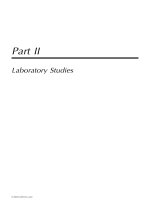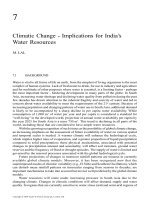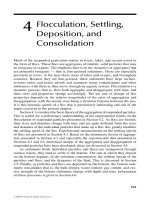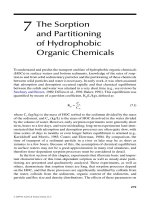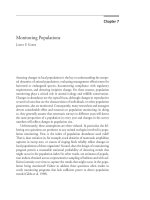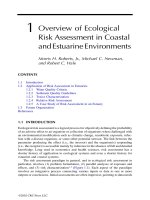Ecological Modeling in Risk Assessment - Chapter 7 pptx
Bạn đang xem bản rút gọn của tài liệu. Xem và tải ngay bản đầy đủ của tài liệu tại đây (501.74 KB, 13 trang )
© 2002 by CRC Press LLC
CHAPTER 7
Population Models — Metapopulations
H. Resit Akçakaya and Helen M. Regan
A metapopulation is a set of populations of the same species in the same general geographic area
with a potential for migration among them (Figure 7.1
). Often there is movement of individuals
(dispersal) among the different populations of a metapopulation, which may lead to recolonization
of empty (extinct) habitat patches. Metapopulation dynamics are important for several reasons.
Many species live in naturally heterogeneous landscapes or in habitats that are fragmented by
human activities, thereby leading to a series of populations of the same species distributed in space.
The dynamics of a spatially structured metapopulation are complicated by the interaction (e.g.,
exchange of individuals) among populations within the metapopulation. The extinction risk of a
metapopulation can be estimated only when all populations are modeled together in a metapopu
-
lation model because partially correlated fluctuations in environmental variables lead to complex
dependencies in their extinction risks. Existence of a species in multiple populations exposes it to
additional threats, such as further fragmentation, isolation, and dispersal barriers, in addition to the
threats that affect each of its populations. Finally, the existence of a species in multiple populations
allows additional conservation and management options, such as reserve design, habitat corridors,
reintroduction, and translocation. Endpoints for metapopulation modeling include the following:
• Metapopulation persistence
• Metapopulation occupancy, local occupancy duration
• Expected abundance, expected variation in abundance
• Movement rates, occupancy rates
• Spatial patterns of occupancy
Typical data inputs for a metapopulation model include the areas and locations of suitable
habitat patches; presence/absence data for the species; carrying capacity; survival, fecundity, and
dispersal rates; parameters for describing catastrophes; and the time series of habitat maps.
Figure 7.1 illustrates the spatial structure of one example of a metapopulation, the California
gnatcatcher.
Metapopulation models reviewed below include (Table 7.1):
1574CH07.fm Page 83 Tuesday, November 26, 2002 5:05 PM
© 2002 by CRC Press LLC
• Occupancy-incidence function, a model for determining the occupancy status of habitat patches
(Hanski 1994; Hanski and Gilpin 1991)
• Occupancy-state transition, a model for predicting the transitions in the status of habitat patches
(Verboom et al. 1991; Sjögren-Gulve and Ray 1996)
• RAMAS Metapop and RAMAS GIS, structured metapopulation models with population dynamics
in each patch (Akçakaya 1998a,b; Akçakaya et al. 1995; Kingston 1995)
• VORTEX, an individual-based metapopulation model (Lacy 1993; Lindenmayer et al. 1995)
• ALFISH (ATLSS landscape fish model), a spatial model of fish in the Everglades (DeAngelis et
al. 1998a; Gaff et al. 2000)
• ALEX (analysis of the likelihood of extinction), a generic metapopulation model (Possingham and
Davies 1995)
• Meta-X, an occupancy status model currently being developed (UFZ and OFFIS 2000)
In this chapter, we also included individual-based population models that have a strong spatial
component. Thus, in this chapter, the term spatial models refers to metapopulation models with
spatial components. For other reviews of metapopulation models, see Gilpin and Hanski (1991),
Breininger et al. (in press), and Akçakaya and Sjögren-Gulve (2000).
We review two occupancy-type models and four software platforms for spatially structured
modeling (RAMAS Metapop and GIS, VORTEX, ALEX, and Meta-X). In an earlier review,
Lindenmayer et al. (1995) compared VORTEX, ALEX, and RAMAS/space (a precursor of RAMAS
Figure 7.1 Schematic of the spatial structure of a metapopulation. Note: This example of a metapopulation is
for the California gnatcatcher in Orange County. (From Akçakaya and Atwood (1997) A
habitat-
based metapopulation model of the California gnatcatcher. Conserv. Biol. 11:422–434. With per
-
mission of Blackwell Science, Inc.)
1574CH07.fm Page 84 Tuesday, November 26, 2002 5:05 PM
© 2002 by CRC Press LLC
Table 7.1 Internet Web Site Resources for Metapopulation Models
Model Name Description Reference Internet Web Site
Occupancy —
incidence function
A model for determining the occupancy status
of habitat patches
Hanski and Gilpin (1991); Hanski (1994) www.consci.org/forum/docs2/ch5.pdf
Occupancy —
state transition
A model for predicting the transitions in the
status of habitat patches
Verboom et al. (1991); Sjögren-Gulve
and Ray (1996)
N/A
RAMAS Metapop and
RAMAS GIS
Structured metapopulation models with
population dynamics in each patch
Akçakaya et al. (1995); Kingston (1995);
Akçakaya (1998a,b)
/>VORTEX An individual-based metapopulation model
commonly used in conservation biology
Lacy (1993); Lindenmayer et al. (1995)
assignments/vortex/vortexguide.html
/>ALFISH A spatially explicit, individual-based model of
fish in the Everglades
DeAngelis et al. (1998a); Gaff et al.
(2000)
/> />html
ALEX A generic metapopulation model applicable to
most vertebrates
Possingham and Davies (1995)
ecosys/Alex/ALEX.HTM
Meta-X An occupancy status model currently being
developed
UFZ and OFFIS (2000)
english/overview.html
Note: N/A - not available
1574CH07.fm Page 85 Tuesday, November 26, 2002 5:05 PM
© 2002 by CRC Press LLC
Metapop). In the Discussion and Recommendations section, we identify gaps in the use of these
models and potential development directions that will make the models more useful.
OCCUPANCY MODELS — INCIDENCE FUNCTION
The simplest metapopulation approach models the occupancy status of habitat patches (i.e., the
presence or absence of the species in the patches) in a geographic region. These models are
parameterized by using data on the presence or absence of a species in habitat patches from one
or more regional inventories and data on environmental variables. They require that the species has
local populations confined to a clearly delimited habitat in a landscape.
Incidence function models (Hanski 1994; Hanski and Gilpin 1991) require data on the areas
and geographic locations of suitable habitat patches and on the presence/absence of the species in
these patches from one complete inventory. A habitat suitability analysis of the species’ pres
-
ence/absence pattern may be required for reliable habitat patch identification and delimitation. On
the basis of these data, colonization and extinction probabilities are estimated for each patch by
using regression techniques. These estimated probabilities are then used in a simulation to predict
metapopulation persistence.
Realism — LOW — Incidence function models incorporate local extinction and recolonization. The
factors they incorporate include size of patches and distance among patches. They ignore local
population dynamics and do not model fluctuations in the sizes or compositions of the local
populations (in terms of sex, age, or stage). They cannot use most available demographic data. The
model assumes that the metapopulation is in equilibrium, which is often invalid.
Relevance — LOW — The main endpoint is metapopulation persistence. The main model parameters
are not directly related to physical or chemical impacts.
Flexibility — MEDIUM — The model has been applied to short-lived species (such as butterflies) in
terrestrial environments and could be extended to other species. The model has only a few species-
specific parameters. The parameters (local extinction risk and recolonization probability) require
observations of locally extinct patches (defined as suitable habitats in which the species of interest
is absent).
Treatment of Uncertainty — HIGH — The model simulates variability in patch occupancy. It can be
used in a sensitivity analysis to incorporate uncertainties.
Degree of Development and Consistency — MEDIUM — No software programs are available for
the model. However, the model structure is simple and would not be too difficult to implement as
software.
Ease of Estimating Parameters — MEDIUM — Some model parameters (such as local extinction
risk) are hard to estimate given typical data sets. Unbiased estimation of parameters requires
observations of several occupied and unoccupied patches, and occupancy may be difficult to deter
-
mine.
Regulatory Acceptance — MEDIUM — No information on the model’s regulatory acceptance is
available. The model is likely to be used by a regulatory agency but is not likely to be formally
adopted for use in developing environmental criteria.
Credibility — MEDIUM — The model is known in academia; several (10 to 100) publications cover
the applications of the model in different cases.
Resource Efficiency — LOW — Applying the model to a particular case requires some programming,
testing, and debugging. In most cases, available data are not sufficient, and additional data collection
is necessary.
OCCUPANCY MODELS — STATE TRANSITION
State transition models (e.g., Verboom et al. 1991; Sjögren-Gulve and R ay 1996) are conceptually
related to the incidence function models discussed previously. They also require presence/absence
1574CH07.fm Page 86 Tuesday, November 26, 2002 5:05 PM
© 2002 by CRC Press LLC
data but from two or more yearly inventories instead of a single snapshot. They predict the transitions
in the status of patches (vacant to occupied as a result of colonization, and occupied to extinct as
a result of local extinction).
Realism — LOW — These models incorporate the processes of local extinction and recolonization.
The factors they incorporate include the size of patches and the distance among patches. They ignore
local population dynamics and do not model fluctuations in the sizes or compositions of the local
populations (in terms of sex, age, or stage). They cannot use most available demographic data.
Relevance — LOW — The main endpoint is metapopulation persistence. The main model parameters
are not directly related to physical or chemical impacts.
Flexibility — MEDIUM — The model has only a few species-specific parameters. The parameters
(local extinction risk and recolonization probability) require observations of local extinction and
recolonization events. Thus, the model is only applied to short-lived species.
Treatment of Uncertainty — HIGH — The model simulates variability in patch occupancy. It can be
used in a sensitivity analysis to incorporate uncertainties.
Degree of Development and Consistency — MEDIUM — No software programs are available for
the approach. However, the model structure is simple and would not be too difficult to implement
as software.
Ease of Estimating Parameters — MEDIUM — Some model parameters (such as local extinction
risk) are hard to estimate given typical data sets. Unbiased estimation of parameters requires several
observations of local extinction and colonization events.
Regulatory Acceptance — MEDIUM — No information on the model’s regulatory acceptance is
available. The model is likely to be used by a regulatory agency but is not likely to be formally
adopted for use in developing environmental criteria.
Credibility — MEDIUM — The model is known in academia; several (10 to 100) publications cover
applications of the model in different cases.
Resource Efficiency — LOW — Applying the model to a particular case requires some programming,
testing, and debugging. In most cases, available data are not sufficient, and additional data collection
is necessary.
RAMAS METAPOP AND RAMAS GIS
RAMAS Metapop and RAMAS GIS implement structured metapopulation models (Akçakaya
1998a,b). Structured metapopulation models incorporate the local dynamics of populations in each
habitat patch. The main advantage of structured metapopulation models is their flexibility. They
can incorporate several biological factors and can represent spatial structure in various ways; they
have been applied to a variety of organisms (Akçakaya 2000). Another advantage is that, despite
their flexibility, structured models were developed on the basis of a number of common techniques
or frameworks that allow them to be implemented as generic programs (such as RAMAS Metapop).
This common framework becomes advantageous when models and viability analyses are needed
for a large number of species and when time and resource limitations preclude detailed modeling
and programming for each species. A third advantage is that structured demographic modeling
allows careful risk assessment for species with very few local populations (occupancy models
require a larger number), even if no extinctions have occurred.
The user can run these metapopulation models to predict the risk of species extinction, time to
extinction, expected occupancy rates, and metapopulation abundance. The programs allow com
-
parison of results from different simulations by superimposing graphs of risk curves, time-to-
extinction distributions, trajectory summary, metapopulation occupancy, and other outputs.
Landscape information imported into RAMAS Metapop/GIS may include GIS-generated maps
of vegetation cover, land use, temperature, precipitation, or some other aspect of the habitat that
is important for the species (Figure 7.2
). RAMAS Metapop/GIS then combines the information in
all these map layers into a map of habitat suitability expressed as a user-defined habitat suitability
function.
1574CH07.fm Page 87 Tuesday, November 26, 2002 5:05 PM
© 2002 by CRC Press LLC
RAMAS Metapop/GIS uses a patch-recognition algorithm and identifies areas of high suitability
as a patch where a subpopulation may survive. The carrying capacity and other population-specific
parameters of this patch (survival, fecundity, maximum growth rate) can be calculated as a user-
defined function of total habitat suitability, average habitat suitability, core area, patch perimeter
(edge), and other habitat characteristics (from the GIS maps) for that patch. RAMAS Metapop/GIS
then displays the spatial structure of the metapopulation superimposed with a color-coded map of
habitat suitability and other geographical features specified by the user. RAMAS Metapop/GIS can
also import a user-defined time series of habitat maps, from which the program creates time series
of population-specific parameters for input into the metapopulation model.
Realism — HIGH — RAMAS Metapop considers processes such as survival, reproduction, dispersal,
local extinction, habitat loss, habitat growth, demographic stochasticity, catastrophes, recolonization,
harvest, translocation, and reintroduction. It incorporates factors such as age structure, stage structure,
environmental fluctuations, density dependence, and correlated environments. It does not incorporate
genetics. RAMAS GIS includes RAMAS Metapop; it links GIS-based landscape data to the habitat
requirements of the species and incorporates wildlife–habitat relationships. The structure of the
models allows all available and relevant demographic data to be used. Model assumptions are
generally realistic.
Relevance — HIGH — The results include risk of extinction, risk of decline, time to extinction, time
to decline, metapopulation occupancy, local occupancy duration, expected abundance, and expected
variation in abundance. The model has several parameters (carrying capacities, survival, fecundity,
dispersal rates, maximum growth rates, catastrophes) that can be used to model implicitly the effects
of habitat degradation, toxicity, hunting/fishing, thermal pollution, timber harvest, and so forth.
Flexibility — HIGH — The model has a large number of parameters that can be modified by the user.
However, the model is not applicable to species with complex social interactions. The model has
been applied to plants, invertebrates, mammals, fishes, birds, reptiles, and amphibians in terrestrial,
marine, and freshwater environments.
Treatment of Uncertainty — HIGH — The model simulates the natural variability in population
parameters such as survival, fecundity, and dispersal. It allows correlated fluctuations. RAMAS
Metapopulation/GIS has a sensitivity analysis feature that allows multiple simulations with auto
-
matically changed input parameters.
Degree of Development and Consistency — HIGH — The model is implemented as user-friendly
software that is easy to apply to new cases. It has a detailed user’s manual that describes the use of
the program and gives background information about metapopulation dynamics and parameter
Figure 7.2 Structure of RAMAS Metapop/GIS. (From Applied Biomathematics
( With permission.)
1574CH07.fm Page 88 Tuesday, November 26, 2002 5:05 PM
© 2002 by CRC Press LLC
estimation. The program includes several internal checks for consistency. It also checks each user
input value for the correct range and for consistency with other input parameters.
Ease of Estimating Parameters — MEDIUM — The model requires more data than occupancy models
— for example, stage-specific survival rates and fecundities and their temporal and spatial variation.
However, in many cases (especially for vertebrate populations), these types of data may be more
readily available than data required for occupancy models (e.g., observations of local extinctions
and recolonizations).
Regulatory Acceptance — HIGH — The model is used by several regulatory agencies in different
countries (the U.S. Fish and Wildlife Service, EPA, Environment Canada, New South Wales National
Parks and Wildlife Service in Australia, and state agencies in the U.S.). The model has been used
in listing threatened species and in species recovery plans.
Credibility — HIGH — The model is widely known in academia and has been positively reviewed in
the literature (Kingston 1995; Witteman and Gilpin 1995; Boyce 1996). The model has more than
300 users (about 450 if RAMAS/space, a precursor, is included).
Resource Efficiency — HIGH — Applying the model to a particular case does not require any
programming. Some cases require additional data collection, but in many cases, available data are
sufficient.
VORTEX
VORTEX is an individual-based metapopulation model (Lacy 1993). VORTEX follows a commonly
used approach in which the behavior and fate of each individual is modeled in a simulation
(DeAngelis and Gross 1992). The behavior and fate (e.g., dispersal, survival, reproduction) of
individuals depend on their location, age, size, sex, physiological stage, social status, and other
characteristics.
The advantage of individual-based models is that they are even more flexible than structured
models and can incorporate such factors as genetics, social structure, and mating systems more
easily than other types of models.
One disadvantage of individual-based models is that they are very data intensive. Only a few
species have been studied well enough to use all the power of individual-based modeling. Another
disadvantage is that their structure often depends on the biology of the particular species modeled.
Thus, individual-based models must usually be designed and implemented for each species sepa
-
rately. However, VORTEX (Lacy 1993) has a fixed, age-based structure, even though it was
developed on the basis of individual-based modeling techniques.
Realism — HIGH — VORTEX considers processes such as survival, reproduction, dispersal, local
extinction, demographic stochasticity, catastrophes, recolonization, and harvest. It incorporates fac
-
tors such as age structure, environmental fluctuations, density dependence, and genetics. The struc-
ture of the models allows all available and relevant demographic data to be used. Model assumptions
are realistic.
Relevance — HIGH — The results include risk of extinction, risk of decline, time to extinction, time
to decline, expected abundance, and expected variation in abundance. The model has several
parameters (e.g., carrying capacity, survival, fecundity, dispersal rates, catastrophes) that can be
used to model implicitly the effects of habitat degradation, toxicity, hunting/fishing, thermal pollu
-
tion, timber harvest, and so forth.
Flexibility — MEDIUM — The model has many parameters that can be modified by the user. The
model does not use stage structure, so it may not be appropriate for some species, such as many
plants. The model is not practically applicable to highly fecund species (such as many fishes) and
to very abundant species. The model does not incorporate habitat relationships.
Treatment of Uncertainty — HIGH — The model simulates natural variability in population param-
eters such as survival, fecundity, and dispersal. It can be used for sensitivity analysis.
Degree of Development and Consistency — HIGH — The model is implemented as software that is
fairly easy to apply to new cases. It has a user’s manual that describes the use of the program and
gives background information about metapopulation dynamics and parameter estimation.
1574CH07.fm Page 89 Tuesday, November 26, 2002 5:05 PM
© 2002 by CRC Press LLC
Ease of Estimating Parameters — MEDIUM — This model requires more data than structured models
(such as those related to genetics and mating system).
Regulatory Acceptance — MEDIUM — No information on the model’s regulatory acceptance is
available. The model is likely to be used by a regulatory agency. The manual has been published
by the captive breeding specialist group of the World Conservation Union (IUCN), an international
conservation organization.
Credibility — HIGH — The model is widely used. No information is available on the number of users,
which is likely to be more than 200.
Resource Efficiency — HIGH — Applying the model to a particular case does not require any
programming. Some features (such as density dependence and age-specific fecundity and survival
for adults) require writing equations. Some cases require additional data collection, but in many
cases, available data are sufficient.
ALFISH
ALFISH (the ATLSS landscape fish model; Gaff et al. 2000) is a component of the across-trophic-
level system simulation, an integrated combination of computer simulation modules designed to
model the biotic community of the freshwater wetlands of the Everglades and Big Cypress swamp
and the abiotic influences on that community (see Chapter 11, Landscape Models). The aim of
ALFISH is to predict the effects of hydrologic scenarios on fish densities in the South Florida
wetland area and the subsequent food availability to wading birds.
In each cell of ALFISH, the variability in water depth and elevation is characterized statistically.
Permanently wet regions such as ponds are modeled explicitly, and all other areas are subject to
drying and reflooding. Fish are not modeled individually and do not move between cells. The
density of fish is modeled deterministically and depends on the varying water depth in each cell,
available food resources from lower trophic levels, and movement between the cells. The model
incorporates two distinct functional groups — those fish 7 cm or less in length and those greater
than 7 cm. The functional groups are modeled with an age–size structure in which each age class
is 30 days. Each age class is divided into six size classes in which length is calculated as a function
of age by a von Bertalanffy equation. The time-step is 5 days, during which fish increase in size
before moving to the next age class every 30 days. Mature fish produce offspring during their
assigned reproductive month, the number and timing of which is determined by parameters specific
to each functional group. Mortality has four manifestations: age-dependent background mortality
in an uncrowded population; density-dependent mortality from starvation; mortality from predation
from other functional groups; and mortality from an inability to disperse to wetter regions after a
cell dries out.
Realism — MEDIUM — The model is realistic in the sense that the major influencing factor on fish
populations, hydrology, is modeled in great detail. The model includes density dependence within
each cell. Population size predictions correlate well with known fish distributions (DeAngelis et al.
1998a).
Relevance — HIGH — The population densities and spatial distributions of fishes are the primary
endpoints of ALFISH. The potential effects of chemicals on fish have not yet been modeled in
ALFISH, but there are plans to model the effects of mercury. Unlike the more comprehensive model
ATLSS, ALFISH does not include simulations of nutrient concentration, bio-uptake, transport, and
fate that can be extended to other chemicals. However, mortality, fecundity, and growth parameters
can be modified to implicitly incorporate chemical effects.
Flexibility — LOW — The spatial component of the model is specific to the South Florida wetland
region, and the stage structure is particular to fish; hence, the model is not flexible enough to
implement for other regions or species.
1574CH07.fm Page 90 Tuesday, November 26, 2002 5:05 PM
© 2002 by CRC Press LLC
Treatment of Uncertainty — LOW — The fish model is deterministic. Except for spatial variation
across the landscape and the variability in pond size within each cell, uncertainty and variability in
the model parameters are not dealt with.
Degree of Development and Consistency — LOW — The model is implemented as software. Although
this software has sufficient documentation, it is not easy to apply to a new system because of its
specific nature.
Ease of Estimating Parameters — MEDIUM — Parameters are relatively easy to estimate because
this model is not individual-based, few parameters are used, and data are available for fish.
Regulatory Acceptance — HIGH — ALFISH is part of ATLSS, which is used by the Federal, State,
and Tribal Taskforce for the Restoration of the South Florida Ecosystem as the primary ecological
tool for assessing water management strategies.
Credibility — LOW — Few publications cover the model’s application.
Resource Efficiency — LOW — Owing to the specific nature of the model, much effort is required
to apply it in a particular case.
ALEX
ALEX is a generic metapopulation model with features that allow it to be applied to most vertebrates
(Possingham and Davies 1995). The main advantages of ALEX include its speed, ability to
incorporate a variety of catastrophes, and ability to allow for habitat dynamics. ALEX simulates
comparatively large populations very quickly and allows the user to specify a wide variety of
environmental processes.
Realism — MEDIUM — ALEX considers processes such as survival, reproduction, dispersal, local
extinction, habitat loss, habitat growth, demographic stochasticity, catastrophes, and recolonization.
It incorporates factors such as age structure and environmental fluctuations. It does not incorporate
genetics. The structure of the model allows most available and relevant demographic data to be used.
ALEX allows a simple age structure with only three classes of individuals: newborn, juvenile, and
adult. It does not allow stage structure.
Relevance — HIGH — The results include risk of extinction, time to extinction, metapopulation
occupancy, expected abundance, and expected variation in abundance. The model has several param
-
eters (e.g., survival, fecundity, dispersal rates, and catastrophes) that can be used to model implicitly
the effects of habitat degradation, toxicity, hunting/fishing, thermal pollution, timber harvest, and
so forth.
Flexibility — MEDIUM — The model has many parameters that can be modified by the user. The
model does not use stage structure, so it may not be appropriate for some species, such as many
plants. The model allows only three age classes, so it may not be applicable to species with delayed
reproduction. The model has been applied primarily to vertebrates.
Treatment of Uncertainty — HIGH — The model simulates natural variability in population param-
eters such as survival, fecundity, and dispersal. It does not allow correlated fluctuations. It can be
used for sensitivity analysis to incorporate uncertainties.
Degree of Development and Consistency — MEDIUM — The model is implemented as software
that is moderately easy to apply to new cases. According to the program documentation, using
ALEX requires some limited input from its author, Hugh Possingham.
Ease of Estimating Parameters — MEDIUM — This model requires more data than occupancy
models — for example, age-specific survival rates and fecundities and their temporal and spatial
variations. However, in many cases (especially for vertebrate populations), these data may be more
readily available than the data required for occupancy models (e.g., observations of local extinctions
and recolonizations).
Regulatory Acceptance — MEDIUM — No information on the model’s regulatory acceptance is
available. The model is likely to be used by a regulatory agency, especially in Australia.
1574CH07.fm Page 91 Tuesday, November 26, 2002 5:05 PM
© 2002 by CRC Press LLC
Credibility — MEDIUM — No information is available on the number of users, which is likely to be
between 20 and 200.
Resource Efficiency — MEDIUM — Applying the model to a particular case does not require any
programming. Some cases require additional data collection, but, in many cases, available data are
sufficient. ALEX is intended for research and education; its use without the author’s permission is
discouraged.
META-X
Meta-X is being developed in Germany by Umweltforschungszentrum Leipzig–Halle Sektion
Ökosystemanalyse (UFZ) and Oldenburger Forschungs- und Entwicklungsinstitut für Informatik-
Werkzeuge und Systeme (OFFIS). We reviewed the beta version of the software.
Meta-X was developed by using the occupancy modeling approach (see above). It models the
occupancy status of patches. As opposed to WESP/ECOTOOLS, which is mainly designed for use
by model developers, Meta-X incorporates options for selecting available models and is intended
for use by ecologists and environmental managers. According to its creators, Meta-X differs from
other programs by directly supporting comparative evaluations of alternative environmental man
-
agement scenarios with respect to their effects on the persistence of the population of concern.
Realism — LOW — Meta-X incorporates local extinction and recolonization. The factors incorporated
include location of patches, distance among patches, and correlations among extinction probabilities
of patches. It ignores local population dynamics and does not model fluctuations in the size or
composition of the local populations (in terms of sex, age, or stage). It cannot use most available
demographic data. The model assumes that local extinction risks are constant over time, which is
not realistic for increasing or decreasing species populations.
Relevance — LOW — The main endpoints are metapopulation persistence and time to extinction. The
main model parameters are not directly related to physical or chemical impacts.
Flexibility — MEDIUM — The model has only a few species-specific parameters. The parameters
(local extinction risk and recolonization probability) require observations of local extinctions and
are not likely to be applicable to long-lived species. The model assumes that local extinction risks
are constant over time and is not applicable to species that are increasing or decreasing in time.
Treatment of Uncertainty — HIGH — The model simulates variability in patch occupancy. It has
special features for sensitivity analysis to incorporate uncertainties.
Degree of Development and Consistency — HIGH — The program is simple to use and comes with
a manual that includes a tutorial.
Ease of Estimating Parameters — LOW — The model parameters for each population (patch) are
probability of local extinction, number of emigrants from the patch per year, and number of
immigrants needed to establish (with 50% probability) a new population. These parameters are
difficult to estimate given typical data sets.
Regulatory Acceptance — LOW — No information on the model’s regulatory acceptance is available.
The model has not yet been published and thus is probably not used by a regulatory agency.
Credibility — LOW — No information is available on the number of users, which is likely to be small.
The model has not yet been published, and only a beta version has been released.
Resource Efficiency — MEDIUM — Applying the model to a particular case does not require
programming. In most cases, available data are not sufficient, and additional data collection is
necessary.
DISCUSSION AND RECOMMENDATIONS
Several of the metapopulation models reviewed, in particular RAMAS Metapop/GIS and VORTEX,
have high realism, relevance, and flexibility and can be used for risk assessment without additional
development (Table 7.2). Metapopulation models have been applied to a variety of species, includ
-
1574CH07.fm Page 92 Tuesday, November 26, 2002 5:05 PM
© 2002 by CRC Press LLC
ing representative insects, frogs, birds, and mammals (Table 7.3). Brook et al. (2000) applied
several existing models to 21 populations. The results both validated the predictions of these models
by comparing their results with observations and showed that models developed by using different
software gave similar results when used with the same data sets.
Further development will make these models more suitable for metapopulation-level risk anal-
ysis. To make the available metapopulation models more useful for chemical risk assessment,
functions could be added such as exposure response curves to model effects of toxic chemicals.
Below, we discuss several other potential developments that will enhance metapopulation models.
One potential development is linking a metapopulation model to a GIS-based model that predicts
future changes in species habitat. RAMAS Metapop GIS already allows a time series of habitat
maps to be input as the basis of the spatial structure of the metapopulation. This feature can be
further developed to allow a direct link with a landscape-level model that predicts, for example,
the changes in the vegetation structure that result from succession and disturbances. The same
approach can be used to link a metapopulation model with a hydrodynamic model that predicts
variables such as flow, temperature, and spread of chemicals in an aquatic environment. Such
predictions can be used to calculate the population-level parameters (carrying capacity, survival,
fecundity, etc.) in each population. The final product would be an integrated model that combines
the physical, chemical, and biological aspects of a system in a risk analysis framework.
Another potential development involves adding the features of a structured model to allow sex
structure. Matrix-based metapopulation models (such as RAMAS Metapop) can be expanded to
model both sexes by (1) allowing the user to input different matrices for males and females and
(2) adding options and parameters for a limited set of mating systems. Such development will
make these models more applicable to species in which behavioral or physiological characteristics
of both sexes may be limiting to population growth.
Most models reviewed in this section were originally developed for terrestrial species, with the
notable exception of ALFISH, which was specifically developed for fish populations in the Ever
-
glades. Although some other models, such as RAMAS Metapop, have been applied to aquatic
organisms, certain additional features would make such models more applicable to species in
freshwater and aquatic environments. These features include different types of density dependence
and catastrophes affecting dispersal rates (e.g., a rare, large dispersal after a 10-year flood in a river
fish metapopulation).
1574CH07.fm Page 93 Tuesday, November 26, 2002 5:05 PM
© 2002 by CRC Press LLC
Table 7.2 Evaluation of Population Models — Metapopulation Models
Evaluation Criteria
Model Reference Realism Relevance Flexibility
Treatment
of
Uncertainty
Degree of
Development
Ease of
Estimating
Parameters
Regulatory
Acceptance
Credibility
Resource
Efficiency
Occupancy —
incidence function
Hanski and Gilpin (1991);
Hanski (1994)
◆ ◆ ◆◆ ◆◆◆ ◆◆ ◆◆ ◆◆ ◆◆ ◆
Occupancy —
state transition
Verboom et al. (1991);
Sjögren-Gulve and Ray
(1996)
◆ ◆ ◆◆ ◆◆◆ ◆◆ ◆◆ ◆◆ ◆◆ ◆
RAMAS Metapop and RAMAS
GIS
Akçakaya et al. (1995);
Kingston (1995);
Akçakaya (1998a,b)
◆◆◆ ◆◆◆ ◆◆◆ ◆◆◆ ◆◆◆ ◆◆ ◆◆◆ ◆◆◆ ◆◆◆
VORTEX Lacy (1993); Lindenmayer
et al. (1995)
◆◆◆ ◆◆◆ ◆◆ ◆◆◆ ◆◆◆ ◆◆ ◆◆ ◆◆◆ ◆◆◆
ALFISH DeAngelis et al.
(1998a,b,c)
◆◆ ◆◆◆ ◆ ◆ ◆ ◆◆ ◆◆◆ ◆ ◆
ALEX Possingham and Davies
(1995)
◆◆ ◆◆◆ ◆◆ ◆◆◆ ◆◆ ◆◆ ◆◆ ◆◆ ◆◆
Meta-X UFZ and OFFIS (2000) ◆ ◆ ◆◆ ◆◆◆ ◆◆◆ ◆ ◆ ◆ ◆◆
Note: ◆◆◆ - high
◆◆ - medium
◆ - low
1574CH07.fm Page 94 Tuesday, November 26, 2002 5:05 PM
© 2002 by CRC Press LLC
Table 7.3 Applications of Metapopulation Models
Model Species/Ecosystem Location/Population Reference
Occupancy —
state transition
Pool frog (Rana lessonae) Sweden Sjögren-Gulve and Ray
(1996)
European nuthatch (Sitta
europaea)
Denmark Verboom et al. (1991)
Occupancy —
incidence function
Butterfly (Melitaea cinxia) Finland Hanski et al. (1996)
Tree frog (Hyla arborea) The Netherlands Vos et al. (2000)
RAMAS GIS Bush cricket (Metrioptera
bicolor
)
Southern Sweden Kindvall (1995, 1999)
California gnatcatcher
(Polioptila californica)
Orange County,
California
Akçakaya and Atwood
(1997)
Helmeted honeyeater
(Lichenostomus melanops
cassidix)
Victoria, Australia Akçakaya et al. (1995)
Florida scrub-jay (Aphelocoma
coerulescens)
Florida Root (1998)
Northern spotted owl (Strix
occidentalis)
Washington, Oregon,
California
Akçakaya and Raphael
(1998)
RAMAS Metapop Zebra mussel Mississippi River Akçakaya and Baker
(1998)
Land snail (Arianta
arbustorum)
Switzerland Akçakaya and Baur
(1996)
Land snail (Tasmaphena
lamproides)
Northwest Tasmania Regan et al. (1999)
California spotted owl (Strix
occidentalis)
Southern California LaHaye et al. (1994)
Golden-cheeked warbler
(Dendroica chrysoparia)
Tex as USFWS (1996a)
Black-capped vireo (Vireo
atricapillus)
Tex as USFWS (1996b)
Cottontail rabbit (Sylvilagus
floridanus)
New England Litvaitis and Villafuerte
(1996)
Rhizomatous shrub (Banksia
goodii)
Albany, southwestern
Australia
Drechsler et al. (1999)
VORTEX Lord Howe Island woodhen
(Tricholimnas sylvestris)
Lord Howe Island,
Australia
Brook et al. (1997)
Leadbeater’s possum
(Gymnobelideus leadbeateri)
Central Highlands,
Victoria, Australia
Lindenmayer et al.
(1993); Lindenmayer
and Lacy (1995a)
Mountain brushtail possum
(Trichosurus caninus)
Central Highlands,
Victoria, Australia
Lindenmayer and Lacy
(1995b); Lacy and
Lindenmayer (1995)
ALFISH Various: small and large fish
as food source for higher
trophic levels
Everglades and Big
Cypress Swamp,
Florida
DeAngelis et al. (1998);
Gaff et al. (2000)
ALEX Leadbeater's possum Southeastern Australia Lindenmayer and
Possingham (1996)
Greater bilby (Lagotis macroti) Australia Southgate and
Possingham (1995)
Gliding marsupial (Petaurus
australis)
Australia Goldingay and
Possingham (1995)
Meta-X No known applications
Metapopulation/toxicant
model
Hypothetical Hypothetical Spromberg et al. (1998)
1574CH07.fm Page 95 Tuesday, November 26, 2002 5:05 PM
